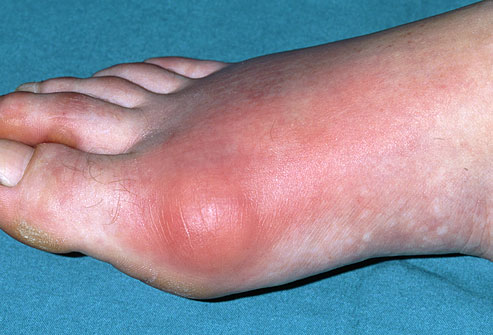Gout: Difference between revisions
No edit summary |
No edit summary |
||
| Line 18: | Line 18: | ||
The most common crystalopathy (in the US) | The most common crystalopathy (in the US) | ||
Rarely seen in children (< 10% of all cases) | Rarely seen in children (< 10% of all cases) <ref name="Goodman, Fuller" /> | ||
Predominantly seen in men (most common inflammatory disease in men over age 30) | Predominantly seen in men (most common inflammatory disease in men over age 30) | ||
| Line 24: | Line 24: | ||
Peak incidence in the 4th - 5th decades of life | Peak incidence in the 4th - 5th decades of life | ||
Frequency increases in postmenopausal women (lack of estrogen) <ref name=" | Frequency increases in postmenopausal women (lack of estrogen) <ref name="Goodman, Fuller" /> <ref name="Goodman, Snyder" /> | ||
== Characteristics/Clinical Presentation == | == Characteristics/Clinical Presentation == | ||
Revision as of 23:52, 15 February 2010
Original Editors - Students from Bellarmine University's Pathophysiology of Complex Patient Problems project.
Lead Editors - Your name will be added here if you are a lead editor on this page. Read more.
Definition/Description[edit | edit source]
Gout is a metabolic disorder; however, because the clinical presentation closely resembles arthritis, gout is also classified as a form of crystal-induced arthritis. [1] [2]There are three main types of gout, all of which usually begin monoarticularly at the first metatarsophalangeal joint and are characterized by sudden pain, swelling, and redness.[1] [2] [3]
Prevalence[edit | edit source]
Effects over 2 million people in the US
The most common crystalopathy (in the US)
Rarely seen in children (< 10% of all cases) [1]
Predominantly seen in men (most common inflammatory disease in men over age 30)
Peak incidence in the 4th - 5th decades of life
Frequency increases in postmenopausal women (lack of estrogen) [1] [3]
Characteristics/Clinical Presentation[edit | edit source]
add text here
Associated Co-morbidities[edit | edit source]
add text here
Medications[edit | edit source]
add text here
Diagnostic Tests/Lab Tests/Lab Values[edit | edit source]
add text here
Causes[edit | edit source]
add text here
Systemic Involvement[edit | edit source]
add text here
Medical Management (current best evidence)[edit | edit source]
add text here
Physical Therapy Management (current best evidence)[edit | edit source]
add text here
Alternative/Holistic Management (current best evidence)[edit | edit source]
add text here
Differential Diagnosis[edit | edit source]
add text here
Case Reports[edit | edit source]
add links to case studies here (case studies should be added on new pages using the case study template)
Resources
[edit | edit source]
add appropriate resources here
Recent Related Research (from Pubmed)[edit | edit source]
see tutorial on Adding PubMed Feed
Extension:RSS -- Error: Not a valid URL: Feed goes here!!|charset=UTF-8|short|max=10
References[edit | edit source]
see adding references tutorial.
- ↑ 1.0 1.1 1.2 1.3 Goodman CC, Fuller KS. Pathology: Implications for the Physical Therapist. 3rd ed. Saint Louis, MO: Saunders; 2009.
- ↑ 2.0 2.1 Beers MH, et. al. eds. The Merck Manual of Diagnosis and Therapy. 18th ed. Whitehouse Station, NJ: Merck Research Laboratories; 2006.
- ↑ 3.0 3.1 Goodman C, Snyder T. Differential Diagnosis for Physical Therapists: Screening for Referral. St. Louis, Missouri: Saunders Elsevier, 2007.
- ↑ Brunilda, N. Gout Pictures Slideshow: Causes, Symptoms, and Treatments of Gout. 2008. http://arthritis.webmd.com/slideshow-gout. Accessed February 15, 2010.








